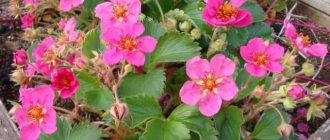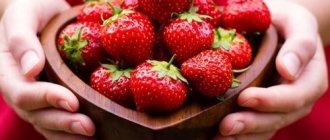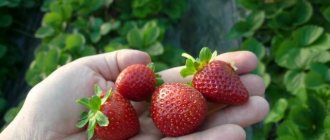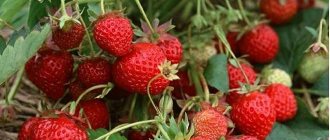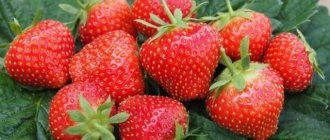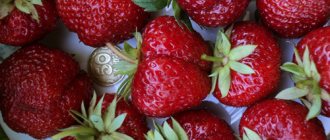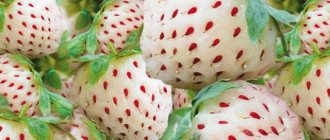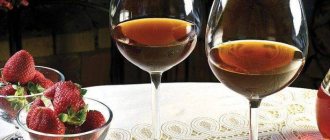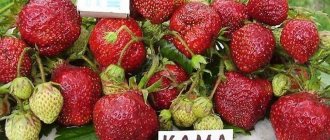Description of the variety and photo
Florence strawberries first appeared in 1997 in the UK. To obtain the variety, breeders used varieties of berry crops such as Vima-Tarda and Vikoda. It is recommended to grow for industrial and dessert purposes. Suitable for cultivation in open and closed ground.
The following advantages can be highlighted:
- The flower stalks of the bushes appear late, after the night frosts have gone. This allows gardeners not to think about covering strawberries. Even if frost returns, the flowers will withstand this test.
- With regular watering, even hot and dry summers are not a problem, since the berries do not bake in the sun and retain their rich juiciness.
- The sugar concentration does not decrease even during rainy summers.
- The fruits tolerate transportation and long-term storage well without loss of presentation and taste.
The variety has certain disadvantages:
- In the absence of proper soil moisture, the yield decreases, they set little and are small in size.
- If the summer is rainy, then there is a threat of late blight, gray mold or brown spot.
- When grown in cold regions, it does not have time to produce a harvest if you do not use covering material in the form of agrofibre.
Important! Once every 3-4 years, strawberry bushes need to be rejuvenated.
Characteristics of the variety
To get a complete picture of the culture, now we will look at the description of the strawberry variety Florence, photos, reviews and learn the rules of agricultural technology. The culture received its main recognition among gardeners due to the subtle forest aroma and excellent taste of the berries. The variety is in demand for industrial cultivation, as it has good endurance and a high yield. Florence received all these qualities from her parent strawberry varieties.
According to the timing of ripening of berries, Florence is considered a late-ripening crop. The fruits begin to ripen when other varieties of early strawberries have already given up their harvest. This period lasts from the end of June to the third decade of July. Under good growing conditions, you can get about 1.5 kg of berries from a bush per season. The fruits are characterized by dense pulp. When ripe, the skin acquires a rich red color. The weight of one berry is in the range of 20–60 g. The shape of the fruit is conical.
Important! Every 3–4 years, strawberry plantings need to be rejuvenated.
Strawberries are very tasty fresh. The berries are used for canning, preparing sweet dishes, and freezing. Florence’s big plus is that after defrosting, the fruits retain their shape, taste and aroma.
Looking at the photo and description of the strawberry variety Florence, it is worth noting that the bush grows powerful, but compact. That is, the plant does not fall apart on the ground. Peduncles stand on strong stems and protrude above the level of foliage. This is a positive characteristic of the variety, since it is easier for the gardener to treat plants with preventive drugs against pests.
From its parents, the Florence variety took good immunity to common diseases. However, moisture accumulation under plants can lead to root rot. This is often observed in rainy summers or when strawberry bushes are densely planted. Root rot can be prevented by arranging wide row spacing. Moreover, they need to be loosened more often. If strawberries are grown under a film cover, frequent ventilation will help get rid of rot.
The strawberry variety Florence is characterized by a small number of whiskers. For the gardener, this indicator is positive, since it becomes easier to care for the plantings. A small number of whiskers does not prevent strawberries from reproducing well. They grow strong and quickly take root when planted in another place.
Winter hardiness of Florence strawberries is high. The plant can withstand frost down to -20°C. The variety was bred in England, and the climate there is humid and cool. Adaptation of the plant to such weather allows it to survive the cold, stormy summer.
Video review of the Florence variety:
To summarize the description of Florence strawberries, let's look at the disadvantages of the variety:
- In hot summers, with a lack of moisture, productivity decreases. There are few berries set and they are all small.
- In stormy summers, there is a threat of late blight affecting strawberries. Gray rot or brown spotting often appears. Such symptoms are observed in areas where a humid climate predominates, for example, the Moscow region. The extent of disease spread depends on the growing conditions of Florence strawberries. The more humid the climate of the region, the wider the row spacing is for better ventilation of the bushes. It is necessary to avoid overgrowing the bed with grass. You may have to discard mulch, as it will retain moisture under the strawberries.
- In cold regions and the Moscow region, the late variety Florence will not have time to fully yield its harvest. Covering the beds with agrofibre will help correct the situation a little.
Despite the large number of shortcomings, the variety has many positive qualities:
- The late appearance of flower stalks in Florence occurs when the night frosts have completely passed. The gardener does not need to cover the strawberries at night. If the stray frost returns, the flowers will not freeze even without shelter.
- Strawberries tolerate hot, dry summers well with regular watering. The berries do not bake in the sun and remain saturated with juice.
- In stormy summers, the sugar content in the pulp does not decrease.
- Florence fruits tolerate transportation well and can be stored.
Advice! To preserve the commercial quality of the berries and increase their shelf life during harvesting, the fruits should be squeezed as lightly as possible with your hands.
Knowing the description of the strawberry variety Florence, its positive and negative qualities, the gardener will be able to clearly determine whether such a crop is suitable for him.
Characteristics of the berry
Forens is considered a late-ripening berry crop. Strawberries begin to ripen after other varieties have given up their harvest. This lasts from the end of June to the end of July.
If all agrotechnical measures are followed (watering, fertilizing, loosening), one bush can produce 1.5 kg of ripe and juicy berries, which are characterized by dense pulp. Ripe fruits have a rich red skin, and one strawberry can weigh 20-60 g. The shape resembles a cone.
Peculiarity! The variety is capable of continuously bearing fruit for 5 years without loss of yield.
The harvested crop is incredibly tasty fresh, and it is also used for canning, making sweet desserts and freezing.
Pros and cons of the Florence strawberry variety
Strawberry Florence has its advantages over other varieties. The main advantages include:
- high yield - up to 1 kg of berries from one bush;
- large berry size - 30-35 g, can reach up to 60 g;
- transportability and long shelf life;
- berries are resistant to climate change and high humidity;
- not capricious to the composition of the soil;
- resistant to diseases;
- The fruiting cycle is 4-5 years.
But there are also obvious disadvantages:
- increased demands on watering;
- reduced yield in hot weather.
When choosing a variety, a gardener always evaluates the advantages and disadvantages. This is necessary not only to determine the best option, but also to comply with the nuances of agricultural technology.
Reproduction
Can reproduce in several ways:
- Mustaches. To perform propagation, it is necessary to use high-quality and strong antennae. Secure it in the ground with wire, and as soon as roots form, you can plant it in open ground.
- Dividing the bush. You need to choose a bush that is already 3-4 years old. Its root system will have to be divided into 2-3 parts, and then each of them should be placed separately in the soil.
- Seeds. This method of reproduction is more labor-intensive. You need to get the seeds from the pulp, then sow them for seedlings in nutritious soil, and after 30 days, with abundant watering and high-quality lighting, the first shoots will appear. As soon as 5-6 leaves are formed on each plant, they can be sent to open ground.
a brief description of
Advantages of the variety
The variety with the romantic name is not easy. It requires constant abundant watering and frequent feeding. Gardeners go to these difficulties for the sake of numerous advantages:
- the fruits are very tasty, with an attractive strawberry aroma;
- flowers bloom when the threat of return frosts has passed;
- with regular watering, it tolerates heat well, the berries do not bake;
- during the rainy season the taste does not become sour;
- undemanding to the type of soil, the main thing is that it is fertile;
- ripe fruits tolerate transportation well and can be stored for a long time;
- late ripening periods attract farmers, the main varieties are already leaving, and Florence is just beginning to bear fruit;
- practically not affected by spotting.
Disadvantages of the variety
- if there is a lack of natural precipitation, mandatory watering is required, otherwise there will be very few berries;
- late-ripening varieties are very loved by wasps and crows;
- in cold damp summers there is a threat of the development of late blight, brown spot and gray rot;
- in cold areas it does not have time to ripen, it is advisable to cover it with agrofibre;
- it is necessary to monitor soil fertility.
Most of the shortcomings can be leveled out by growing indoors.
Landing
Planting work is carried out in early September, but here you need to pay attention to the climatic features of the region. The colder it is, the earlier you need to plant the strawberries so that they have time to take root before winter. If the plant takes root well, it will begin to grow quickly in the spring and throw out flower stalks.
Selecting a location
The planting site should be bright with diffused sunlight. Only slight shade is allowed, but this will increase the acidity of the berries. Any soil with added sand is suitable for Florence.
If you choose clay soil, then be sure to add organic matter to it. It is not recommended to plant on waterlogged soil, as the berries will rot before they have time to ripen.
Attention! When purchasing seedlings, it is important to pay attention to the root system. If it is dried out, then most likely (90%) the plant will not take root. It is better to purchase planting material in cups when the roots are covered with soil.
Site preparation
Preparation should take place a month before the intended planting. Procedure:
- Remove all weeds.
- For 1 sq.m. add 30 kg of humus to the beds.
- Spread the organic matter over the area in an even layer, and then dig it in with the soil.
- If the soil acidity level is increased, add additional chalk.
- Form a bed 5 days before planting so that the soil has time to settle.
Planting seedlings
Planting activities are carried out in compliance with the following recommendations:
- Dig holes in the garden bed. Their sizes must correspond to the size of the root system. Most often, gardeners make holes with a diameter of 12 cm. A distance of 40 cm must be maintained between the holes. This distance cannot be reduced, since the Florence variety is characterized by a powerful bush structure.
- Moisten the soil in the hole with 300 ml of water at room temperature.
- Lower the planting material into the hole, straighten the roots, and then sprinkle with soil, lightly compacting it with your hands. If the plant was planted correctly, the growth point will be at ground level.
- Water the planted seedlings again with water, and to retain the moisture longer, lay a layer of mulch 2-3 cm thick near the bushes. Sawdust or thoroughly rotted humus are suitable for these purposes.
Further care
For rapid rooting and proper vegetation, strawberries of the Florence variety require irrigation, loosening of the soil, and getting rid of weeds. To combat pests and diseases, pruning and processing are carried out.
Watering and fertilizing
Newly planted young plants are watered daily. After 2 weeks, watering is halved. An adult strawberry bush, Florence, requires weekly irrigation in a volume of 10 liters per 1 square meter. m. In preparation for winter, the crop is moistened abundantly for the last time during the season.
An excess of moisture causes no less harm than a lack. When watering crops, they are guided by weather conditions and soil moisture. To prevent strawberry fruits from becoming sour, the crop is intensively fed.
In the spring, a year after planting, the soil is watered with infusion of mullein or chicken droppings (0.5 liters for each bush), and ash is scattered between the rows. When strawberries bloom, the need for phosphorus-potassium fertilizers increases. The bushes are sprayed with a solution consisting of a bucket of water, nitroammophoska in the amount of 2 tbsp. l., potassium salt (30 g).
In autumn, to increase the winter hardiness of the crop, humus and compost are added to the soil at the rate of 4–5 kg per 1 sq.m.
Loosening and mulching the soil
Loosen the soil in the bed with Florence's strawberries the next day after each irrigation, during weeding
If you can go 10 cm deeper between rows, it is recommended to be careful around the bushes and not to loosen deeper than 3 cm
Mulching is mandatory in preparation for winter, and during the season it makes maintenance easier, reducing the amount of irrigation and weeding. Mulch serves as additional nutrition for strawberries and prevents contact of fruits with the ground.
Trimming foliage and tendrils
The formation of whiskers on strawberry bushes of the Florence variety reduces the intensity of fruiting, thickens the plantings, creating favorable conditions for pests and the development of diseases. Therefore, the whiskers are cut off, except for those left for reproduction.
It is recommended to trim the leaves of the crop immediately after harvest, leaving a 3-centimeter stubble. In this case, by winter, new leaf plates will have time to grow, protecting the bushes from freezing.
Diseases and pests: prevention and treatment
Failure to comply with the rules of agricultural technology leads to the appearance of diseases common to the Florence variety:
- Verticillium wilt. The mycelium of the fungus Verticillium dahliae clogs the water-conducting vessels of plants, releasing toxins that spread throughout all organs of the plant. The root is most affected and becomes loose. The leaf blades on the bushes dry, turning yellow and red. For prevention and treatment, the drugs Benorad and Fundazol are used.
- Gray rot. The above-ground part of strawberries is affected. Brown spots on the fruit increase in size, and a gray coating appears. The berry becomes inedible and dries out. Prevention of the disease - absence of mechanical injuries, rationing of fertilizers, treatment of bushes before flowering with Bordeaux mixture, manganese solution. Ready-made products Horus and Teldor are suitable for therapeutic treatments.
- Powdery mildew. Strawberry leaves are covered with a whitish coating on top, which over time turns into dense fluffy spots. The leaf blades of the crop curl and fall off. The spores spread to other organs, inhibiting the plant. At the beginning of the growing season and again after 2 weeks, the bushes are sprayed with Topaz solution.
Of the insects that harm Florence's strawberries more than others:
- strawberry weevil, which can be gotten rid of with iron sulfate, Decis, Karate products;
- aphids, which are fought with the drugs Actellik, Aktara, the bushes are dusted with tobacco and ash;
- black flea flea, against which a solution of calcium arsenic acid is effective, treatment with Karbofos.
Agrotechnical measures that reduce the risk of crop contamination by viruses, fungi, and attacks by parasitic insects:
- frequent weeding and loosening;
- rationing of watering, introduction of microelements;
- mustache trimming.
Natural insecticides (marigolds, nasturtium, calendula) planted on or next to a strawberry bed repel insects.
Do I need to cover it for the winter?
If in the region where Florence strawberries grow, the thermometer in winter does not fall below -20°C, and the snow cover is at least 30 cm, the crop is not insulated. During more severe or snowless winter periods, the crop requires insulation with mulch, spruce branches, film or agrofibre.
Care and feeding
The leaving process is as follows:
- Removing the mustache. Thanks to this procedure, it is possible to prevent thickening of the bushes, which reduces yield and promotes the development of fungal diseases. For propagation, you can leave only 2 shoots, but after harvesting.
- Feeding. This variety has a positive effect on the introduction of nutritional components, as a result of which the bush develops faster. As soon as the first buds and ovaries appear, the plant must be fed with potassium and phosphorus. Before wintering you need to add humus. To do this, combine water and fermented manure in a ratio of 1:4.
- Sun protection. The variety is accustomed to growing in the English climate, so when grown in the southern regions in the heat, the plant will not feel comfortable. To cover the bushes, use regular or reinforced polyethylene.
- Protection from cold. For the winter, the plantings must be covered using thin branches, pine needles or straw. The covering material will protect the bark system from freezing if the winter is snowless.
Interesting! If you freeze a berry, its taste will not deteriorate at all, but will be preserved along with its juiciness.
Reproduction methods
Propagating Florence strawberries by seeds is an exciting activity, but it does not guarantee the production of seedlings with complete preservation of maternal characteristics. It is faster and more reliable to propagate the crop using mustaches (rosettes), dividing the bush into parts.
Seeds
Large, viable strawberry seeds are formed in the lower part of the fruit. To obtain planting material yourself, cut off the top of the berry, leaving the middle and lower parts. After drying, the pulp is rubbed with your palms. The resulting seeds are hardened in the refrigerator for 3 months, placed in a saucer on damp gauze. Make sure that the fabric does not dry out.
Soil for growing crops is purchased at the store, turf soil is combined in equal proportions with humus, peat, sand, or peat tablets are used.
Algorithm for planting and growing strawberry seedlings of the Florence variety from seeds:
- the seeds are placed in a container on top of a moistened substrate and lightly pressed down;
- cover it with glass, film, place it on the windowsill on the side of the apartment where the lighting lasts longer;
- Before germination, the soil is moistened as it dries, the plantings are ventilated when condensation forms on the glass;
- the shelter is removed as soon as the shoots appear;
- When one or two leaves grow, the strawberries are picked.
The requirements for self-grown seedlings are the same as for purchased ones - 3-5 leaf blades, roots -5-7 cm, developed top bud (heart).
Usami
Strawberry Florence produces a moderate amount of mustache. When renewing plantings, there are enough rosettes grown independently.
To obtain creeping shoots from bushes, perform the following activities:
- select strong, 1–2-year-old plants that bear fruit and remove flower stalks;
- after harvesting, they wait until the rosettes closest to the mother bush take root;
- The strawberry shoot is cut off from the outside, the roots are covered with soil;
- The rosette is cared for like an adult plant.
When 4–5 leaves grow, the root reaches a length of 7 cm, the seedlings are separated from the bush and transplanted to a prepared permanent place.
Dividing the bush
The method of dividing strawberry bushes is used when there is a lack of mustache. Adult 3–4 year old plants are selected. The bush is dug up, dried organs are removed, flower stalks are torn off, and divided into parts. Experienced gardeners recommend holding the event in a basin of water - this way the horns are easier to separate from each other.
Diseases and pests
If not properly cared for, the following diseases can occur:
- Gray rot. The main reason for its development is the lack of ventilation and excess moisture. The disease manifests itself in the form of brown spots on the berries and leaves, and after a while the fruits begin to dry out. To combat gray mold, the following recipe will help: dilute 20 g of Bordeaux mixture in 1 liter of water. Use the spray solution and repeat it again after 10 days.
- Powdery mildew. This is a fungal disease that causes a white coating to appear on the leaves. The main causes of the disease are high temperature and excess moisture. To combat powdery mildew, the following solution will help: combine 10 liters of water, 2 liters of whey, 10 drops of iodine and 40 g of wood ash. The solution should be used to water the affected bushes.
- Verticillium. With this disease, the leaves wither, fall off, and their color changes to pink-yellow. The disease mainly affects those bushes that grow near weeds. To combat it, it is better to use a solution of Fundazol (10 g per 10 liters of water).
Among the pests that remain dangerous are:
- Whiteflies are white insects, 1.5 mm long, located at the bottom of the leaf and suck the juice out of it. To protect strawberries, you need to spray the bushes before flowering and after fruiting with insecticides.
- Weevil. A bright green beetle, 12 cm long. It infects leaves by sucking out the juice. Confidor and Decis are effective in combating them.
Advantages and disadvantages of the variety
In order to achieve the best results when cultivating this variety on a personal plot, it is worth assessing all its advantages and disadvantages. This will make it possible to correct errors in care in a timely manner or avoid them altogether.
- Advantages of the Florence strawberry variety:
- high productivity;
- good resistance to frost, drought, diseases and pests;
- undemanding to soil quality;
- ease of care;
- excellent taste and marketability of the harvest;
- low educational ability.
- Among the disadvantages are:
- susceptibility to brown spot and root rot when the soil moisture level is too high. However, if you follow all the rules of agricultural technology throughout the season, this problem can be avoided.
Reviews from gardeners
Valentina, Moscow region: “I have been growing Florence for the 3rd year now. Due to the climate, I cover the bushes well with agrofibre for the winter. With the onset of spring, green foliage begins to actively grow and develop. Ripe berries turn out to be a little sour, but apparently the conditions for the variety are unacceptable.”
Irina, Kemerovo: “I plant it in a sunny area. This is the second year I have been collecting a lot of berries. They are very tasty and aromatic, so I use them both fresh and for jam. But the plants are finicky when it comes to caring for them, so somehow I started this business and the yield immediately decreased.”
Rules for harvesting and storing crops
Harvesting is carried out 8–10 times as it ripens, usually after two to three days. Berries should be picked in the morning, when the dew has disappeared. It is not recommended to collect during rain or extreme heat. Strawberries must be picked carefully, along with the stem, and placed in shallow boxes.
Strawberries make incredibly tasty liqueurs.
Florence strawberries have a significantly longer shelf life (5-6 days) than other varieties (usually 2-3 days). If you haven’t had time to use it fresh, you can make jam, preserves, compote or liqueur. Florence berries tolerate freezing very well - after thawing, their taste practically does not change.
Video: Florence's strawberry harvest
Reviews
- Mikhail: “I got “Florence” relatively recently, so I haven’t yet formed a clear opinion about this variety. On the one hand, I am very pleased with its productivity and the excellent taste of the berries. On the other hand, I am a supporter of more undemanding varieties, because there is neither the strength nor the opportunity to spend all the time at the dacha. “Florence” is capricious in this regard, because without fertilizing the berries become noticeably smaller and sour in taste. In general, if you approach this matter responsibly, you can quickly recoup all costs. In the near future I want to organize a greenhouse shelter and try this growing method.”
- Tatiana: “I purchased strawberries “Florence” at the exhibition, and only five seedlings. The owner assured that it could be propagated without problems in literally a year. It didn’t work out that way for me, and besides, three sprouts simply didn’t take root—already at home I discovered that the roots were almost completely dry. The remaining two specimens were planted for a trial period, but grew surprisingly well and began to actively displace other varieties. “Florence” is my favorite right now, right after the early “Olivia.” The taste of the berries is very difficult to describe, because it contains not only sweetness, but also a distinct sourness. Oddly enough, this is what makes it unforgettable, in my opinion, it is one of the most unusual strawberries I have tried.”
Pests
In addition to diseases, the bushes are plagued by pests, for the extermination of which it is recommended to use a number of measures. In addition, harmful insects can become carriers of diseases.
Strawberry whitefly
This is a very small insect, similar to a white butterfly, 1.5 mm long. They settle at the bottom of the leaf plate, suck the juice out of it, and lay eggs on it. The larvae stick to the leaf blades of the bush and are not visible. They do not like sunlight and hide in shaded areas. They overwinter in the upper layers of soil and plant debris. For protection, treat the bushes with pesticides before flowering and after harvesting.
Leaf beetle
The bug, whose size ranges from 3-4 mm, is brown in color. It actively destroys the pulp of leaves throughout the growing season. It is mainly activated during the flowering period of bushes and ripening of berries.
For prevention, it is necessary to weed out cinquefoil and wild rosemary around the beds, since the beetle uses them for food. Loosening the soil destroys the beetle pupa and makes it accessible to other insects. Before flowering begins, it is recommended to treat with Karbofos or a similar insecticidal preparation. In early spring, pollinate the ridges with tobacco dust.
Nematode
These are transparent worms. They settle in plant tissues and feed on its sap. It is impossible to cure strawberries; the bushes must be removed along with the root ball. Treat the ground with a solution of copper sulfate 5%.
Care
There is nothing difficult in caring for Florence:
- Plants of this variety love moisture very much, so they need to be watered generously periodically. If you don’t do this, the berry will grow small;
- The hybrid responds well to feeding. In the spring, strawberries need nitrogen-containing fertilizer, before flowering begins - phosphorus and potassium fertilizers, and in the fall they add organic matter;
- The soil around the bushes is kept clean, weeds are selected and organic debris is removed. This is done to avoid illness;
- with the help of loosening, they provide oxygen access to the roots;
- Before wintering, cut off the entire above-ground part of the strawberry, leaving only a few centimeters, and cover it if necessary.
Diseases
There are several diseases that will cause unpleasant consequences in strawberries:
- Gray rot - appears in humid weather in thickened plantings and little ventilation. The main manifestations are brown spots with a coating on the foliage and berries, and drying out of the berries. You can get rid of it by removing weeds, treating the soil with lime, planting strawberries next to onions;
- Powdery mildew - appears from high humidity and environmental temperature, damage to the leaves and the heart of the plant. The manifestation is considered to be spots of white dust on the foliage, thickening and wrinkling, berries rotting over time, and the death of the whiskers. To combat this disease, you need to maintain a distance between planted plants, do not overdo it with watering, disinfect the roots with copper sulfate, and fertilize. For treatment, it is necessary to collect and burn old foliage, treat diseased plants with whey diluted with water and iodine;
- Verticillium is one of the most dangerous diseases that can destroy most of the crop. The bush begins to wither, the leaves settle to the ground, the leaves become pinkish-yellow, and there is a brown ring on the roots. This indicates damage to the plant’s vascular system. The main causes of this disease are considered to be a large number of weeds. Therefore, to combat it, the area is cleared of unnecessary vegetation and the use of special preparations.
By following simple prevention rules, you can avoid the occurrence of various strawberry diseases. It can be grown both in large production facilities and in a regular greenhouse. The most important thing is to constantly feed, treat with special means, loosen the soil and avoid arguing. Then on your table in the summer there will be delicious strawberries of the Florence variety.
According to reviews from gardeners with many years of experience, this variety should be planted in the fall. In spring, constant feeding of plants is necessary. Chicken manure is perfect for this purpose. Strawberries of the Florence variety have excellent transportability and do not spoil for a long time. The berries of this variety make delicious preserves, aromatic jams and compotes. With proper and careful care of plants, you can get delicious, sweet berries at a time when all the strawberries have already died.
Rules for caring for strawberries
Obtaining a large quantity of high-quality harvest directly depends on proper and good care. Strawberry Florence needs regular watering and the addition of microelements.
Immediately after planting strawberries in the garden, watering is carried out every three days. Calculate 10 liters of water per square meter. m. As soon as the bushes adapt to the new location, irrigation is reduced to once every 7 days.
The need for moisture increases during strawberry flowering, and during the fruiting stage, watering should be reduced. It is enough to moisten the beds once every two weeks.
Top dressing
Since the bushes and the berries themselves are large in size, repeated application of fertilizers is required throughout the growing season:
- In spring, nitrogen is required, which promotes the development of the above-ground part of the plant. In early spring, it is also recommended to add compost or humus.
- With the appearance of the ovaries, it is necessary to add compounds based on potassium and phosphorus.
- After harvesting most of the crop, a solution of chicken manure is used.
- In autumn, adding humus or rotted manure is useful. The components will strengthen the roots and give the plant strength for a successful winter.
Preparing for winter
Harvesting is carried out up to 9 times per season, every 3-4 days. It is advisable to pick berries in the morning after the dew has disappeared. The fruits are picked carefully, along with the stalk, and placed in boxes.
The fresh harvest is stored at temperatures from 0 to -3 for six days. For longer storage, the berries are frozen or made into sweet dishes. Even after defrosting, the berries do not lose their shape, aroma and wonderful taste.
| Rule 1. Irrigation Strawberries need regular watering: 1. After planting seedlings and before fruit set, the crop especially needs water. Therefore, during this period, strawberries are irrigated twice a week. In this case, 1 m² of beds should contain 10 liters of moisture. 2. When the berries begin to be filled, the watering scheme changes. The crop is watered only once every 7 days. 3. When the harvest is harvested, the strawberries are watered once every 2 weeks. 4. Irrigation of the crop stops after it is covered for the winter. | |
| Rule 2. Feeding In order for strawberries to develop normally and bear fruit well, they must be fed regularly: 1. In March-April, at the beginning of the growing season, the crop needs nitrogenous substances (urea, ammophos or ammonium nitrate). They allow strawberries to form ground organs faster and better. Before use, the fertilizer is diluted in water at the rate of 120 g/10 l. 2. During flowering, fruit setting and filling, strawberries are fertilized with a phosphorus-potassium complex. It will increase crop productivity. The complex is diluted in water at the rate of 90 g/10 l. 3. Before covering the bushes for the winter, they are fed with compost, cow humus or other organic matter. This is done at the rate of 10 kg of fertilizer per 1 m² of beds. This feeding will give strawberries the strength to survive the winter. | |
| Rule 3. Hilling Once every 2 weeks, the soil in the root zone of the bushes is treated:
The procedure improves air and moisture exchange in the root zone of plants. At the same time, more water, oxygen and nutrients reach their roots | |
| Rule 4. Protection from diseases Once every 2 weeks, starting in April, strawberries are sprayed with fungicides. These drugs prevent the risk of crop damage by fungal and bacterial diseases. The following fungicides are suitable for strawberries:
| |
| Rule 5. Formation Do not let strawberries grow extra tendrils. Otherwise, strawberry yields will drop. As the stepsons grow to a length of 10 cm, they are pinched. | |
| Rule 6. Insulation for the winter To protect strawberry bushes from winter cold, they are covered with a layer of hay or straw. Agro-film is then spread over the mulch. In a warm climate and sufficient snow thickness, the crop does not need shelter. |
Requirements for planting seedlings
It is better to choose young seedlings in separate pots . Such specimens with a closed root system quickly adapt to new conditions and take root.
Tubers can be planted in spring and autumn, but the ideal time is considered to be early September, when there are no frosts at night. If planting is done in the spring, then it is necessary to cover the bushes with geotextiles at night.
For strawberries, you need to choose a site on a hill so that groundwater and heavy rains do not cause rotting of the roots.
Preparing the beds begins with digging up the soil. Old roots and weeds, as well as debris, should be removed from it . Any variety of strawberry loves nutritious soil, so a month before planting, fertilizers (organic matter, mineral bait) are introduced into it.
It is better to choose seedlings in separate cups
Before planting, it is necessary to add dolomite flour as fertilizer.
Before planting, the surface of the site is sprinkled with dolomite flour to deoxidize it. After processing, the soil settles for a couple of days. This is necessary to stabilize soil processes and enrich them with nutrients.
The size of the formed bushes is considerable, so the holes are planned at a distance of 30-35 cm from each other.
During the growth process, plants need space, and close proximity will slow down development and reduce productivity. In addition, the density of greenery provokes the formation of various diseases.
In a prepared hole 10-15 cm deep, you should make a small mound and place a seedling on it. The root neck should be flush with the soil surface. Mulch is laid on top around the bush. Planting is completed with abundant watering.
Climate and growing regions
The variety has fairly good frost resistance. It can withstand frosts down to -25 °C. The plants tolerate both high humidity and hot summer weather, so Florence can be cultivated over a wide area.
Strawberries of this type are grown in the Southern regions, in the Central regions, in the Volga region, in the Middle Zone, in the North-West and even in Siberia (under film cover).
How to plant berries?
The English aristocrat is surprisingly very undemanding about the composition of the soil. It takes root well on sandy and loamy soils, but when the proper amount of humus is added, it is quite capable of producing a good harvest on clay soil. It is better to purchase young plants in separate containers. Such seedlings with a closed root system will better take root and adapt to new growing conditions.
Despite its relative unpretentiousness, this variety will not bear fruit well under unfavorable growing conditions. Regular and sufficient watering is very important, without which the berries will become small and tasteless.
Main nuances of cultivation:
- Plantings should not be allowed to thicken, otherwise this will negatively affect crop yields. To prevent such situations, you should trim your mustache in a timely manner. For propagation, you can leave a few of the strongest ones, but only after the main harvest has been harvested.
- Fertilizer application must be done regularly. At the beginning of the season, nitrogen is used for better formation of the above-ground part. Phosphorus and potassium are necessary during the period of budding and ovary formation. At the end of the season, it is imperative to use humus or a solution of fermented manure to give the roots the necessary nutrition before wintering.
- The variety is not intended for too hot regions. Like most English strawberry varieties, it prefers moderate warmth. In hot summers, additional shelter can be used to protect the fruits.
- To protect the plant from attacks by pests, spraying with insecticides is used.
- For winter shelter, it is advisable to use straw mats, peat and special agricultural film. Such protection will help you survive snowless winters, as well as sudden temperature changes. Under favorable conditions and a sufficient level of snow cover, strawberries of this variety do not need additional shelter. It is also worth learning more about the features of caring for the Ostara variety in this article.
The hybrid variety "Florence" has enviable characteristics and will be a worthy reward for the gardener due to its excellent taste and high yield of the plant. At the same time, such strawberries have quite strict requirements for fertilizing, as well as some nuances when planting. You may also be interested in learning more about existing reviews from gardeners about the Roxana variety.
For strawberries, you should choose a suitable place, calculate the planting time and properly prepare the soil. If these conditions are met, the harvest will be high, and the berries will be sweet, without voids.
Selecting a location
When choosing a place to plant Florence strawberries, a number of conditions must be observed:
- the land plot must be level;
- temporary shade is allowed only at lunchtime;
- strawberries love loose, fertile soil with a high content of sand or loam and good aeration;
- if there is groundwater nearby, then a small hill should be made;
- beds must be protected from drafts.
When to plant?
Both spring and autumn planting of strawberry bushes is allowed. Carrying out the procedure in each season has its own characteristics:
- In autumn, planting begins in early September. Before frost, the plant will have time to take root, and the first fruits will appear next summer. It is important to cover young seedlings for the winter, otherwise there is a high risk that the roots will die and the plant will die.
- If you plant the bushes in the spring, you will be able to harvest the harvest only after a year. Before the end of frost, the beds must be covered at night. In summer, it is recommended to remove the tendrils and peduncles so that all the nutritional components go to the development of leaves and roots.
In any season, planting begins only when the soil warms up to 14 degrees. It is better to plant strawberries in rainy or cloudy weather.
Site preparation
The selected area for planting strawberries is dug up in the fall, weeds are removed and fertilizers are applied (humus is suitable). If the acidity of the soil is high, then liming is carried out.
Planting principles
Planting strawberries Florence includes a number of subsequent steps:
- holes are dug in the area with a depth of 18 cm and a diameter of 11 cm;
- the interval between the recesses is made at least 41 cm;
- the hole is moistened and fertilized;
- at the bottom of the hole they make a mound on which they plant a bush and straighten the roots;
- cover with earth and lightly press down.
After planting, it is advisable to mulch the soil with straw, sawdust, and rotted humus.
